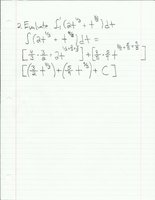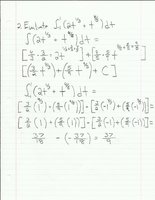Hckyplayer8
Full Member
- Joined
- Jun 9, 2019
- Messages
- 269

I left the two terms separate cause I figured the Algebra needed to combine the two wasn't worth it considering my upper and lower bounds were [-1,1]. Therefore (pending my antiderivative is correct) I can plug in my bounds which will eliminate the powers since 1 to any power will be 1. Then it is just a matter of summing the fractions.

